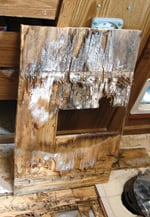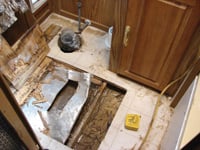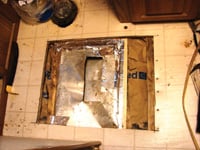Easy Wat to Repair a Rv Camper Trailer Floor
Many folks who love—and preserve—an older RV have found a painful reality in their treasure: soft spots in their flooring. Usually the problem can be traced back to a water leak that's compromised the integrity of the floor. You can sometimes ignore it for a while, but it can get downright dangerous. Having a guest fall through your bathroom floor is not a pleasant thought.
Replacing a bad spot in the floor is challenging, but not impossible for the do-it-yourselfer. It takes time and patience, and at times a bit of imagination. We'll walk you through the process.
Out With the Old
 We recently undertook to solve a soft floor problem in our elderly travel trailer. A previous owner had let a toilet leak go to the point that an area of the plywood floor in the center of the bathroom finally developed dry rot. When we first adopted the trailer we did our best to ignore it, but after a few months, it became apparent that ignorance wasn't bliss. Something had to be done.
We recently undertook to solve a soft floor problem in our elderly travel trailer. A previous owner had let a toilet leak go to the point that an area of the plywood floor in the center of the bathroom finally developed dry rot. When we first adopted the trailer we did our best to ignore it, but after a few months, it became apparent that ignorance wasn't bliss. Something had to be done.
The first step in dealing with nasty floor rot is to pray intensely that the underlying floor material is plywood. Particle board flooring is a curse, and will quickly turn to powdery fluff. Much can be learned by dismounting a floor heat register near the crime scene and taking a squint at the floor material underneath. We found 3/4-inch plywood under our vinyl floor, which meant we'd only need to cut into "solid wood" a few inches beyond the damage. If you've got particle board rot, you'll be cutting a long way back.
By judicious tapping and pressing, we managed to figure out how large an area of soft wood we were dealing with, and then went a few inches farther away from the soft spot and determined that this would be the floor area that we would cut out. Using a square and a felt-tip marker, we carefully drew out a rectangle on the floor as the target lines for our cut. Setting a circular saw the thickness of the floor (and no more), we then cut along the lines. From there it was a matter of using a pry bar and hammer to wrench the old plywood out of the hole, as the manufacturer had used plenty of long staples to install the original plywood decking.
If at all possible, it's best to leave the old plywood intact, as opposed to beating it into little pieces. This can give you a template to use in cutting the replacement wood. However, in our case, the vinyl flooring was only fastened to the plywood around the borders, so we were able to use the cutout flooring as our template piece.
With the plywood out of the hole, you'll probably have plenty of work to do to get the remaining staples out of the floor joists. We found that grabbing the staple close to the joist with diagonal pliers, and then twisting the pliers on the joist gave enough leverage to yank the long-legged staples out of the wood. A shop vac will quickly suck up the dust and plywood fragments, keeping your work area clean and making it much easier to work.
Preparing for Replacement Plywood
 You'll need to create a new base of support for your replacement plywood. In some cases, you may be able to use suitably sized dimensional lumber to create new floor joists, but there will be areas where you can't run and attach them to the existing joist system. Since you can't have the new (and remaining good) plywood hanging in midair, you'll use a system of cleats to form that support.
You'll need to create a new base of support for your replacement plywood. In some cases, you may be able to use suitably sized dimensional lumber to create new floor joists, but there will be areas where you can't run and attach them to the existing joist system. Since you can't have the new (and remaining good) plywood hanging in midair, you'll use a system of cleats to form that support.
Basically a cleat is a chunk of dimensional lumber (2 x 4s are good for this) laid on its side, and tucked underneath the edge of the good remaining plywood. Stick the cleat up under the existing plywood so that half of the cleat is sticking out from under the plywood, like a tongue. Using 2 1/2-inch drywall screws, we drove screws down through the existing flooring into the cleat, spacing the screws close to 3 inches on center. When you lay the new plywood replacement piece in the hole, it will be supported by the cleat and you simply run screws through the new plywood into the cleat. Voila! The new "plug" is firmed into the spot.
In some areas you may be very close to an existing floor joist—say the cut is right along the edge of a joist. In this case you can make a "sister" by screwing another joist piece onto the existing joist. Here the plywood screws into the sister.
You Aren't Done Yet
 Alas the width of the circular saw blade will likely leave a kerf that's seemingly as wide as the Grand Canyon. Depending on what you'll use for replacement floor coverings, those nasty cracks need to be filled up. The floor-leveling compound sold at lumberyards works OK for sticks-and-bricks homes, but it's a plaster-based substance that easily cracks with motion. Bounce your RV down the highway a few times and if your floor-leveling compound breaks up, you'll have it ruining your new flooring. We were stumped for a while.
Alas the width of the circular saw blade will likely leave a kerf that's seemingly as wide as the Grand Canyon. Depending on what you'll use for replacement floor coverings, those nasty cracks need to be filled up. The floor-leveling compound sold at lumberyards works OK for sticks-and-bricks homes, but it's a plaster-based substance that easily cracks with motion. Bounce your RV down the highway a few times and if your floor-leveling compound breaks up, you'll have it ruining your new flooring. We were stumped for a while.
Then a contractor friend said, "Bondo it!" Sure enough, automotive body filler was our answer. This had to be the longest part of the job. Mixing the fiberglass-like compound up, smoothing it into irregularities and cracks, drying it, then sanding it with a belt sander seemed to take forever. Don't try to fill deep voids or irregularities in one shot; you'll need to come after them in a multi-layered approach. If you're recovering with vinyl, be sure your screws are driven down deep and covered with body filler. And be sure to follow the precautions with regard to safety. Boxed up in an enclosed RV with fumes from this stuff filling your lungs is a surefire way to damage your organism.
If you're doing a replacement vinyl floor, you'll really need to pay close attention to getting this floor prepping done smoothly, as imperfections will show. Laminates or carpeting cover a multitude of sins.
Russ and Tiña De Maris are authors of RV Boondocking Basics—A Guide to Living Without Hookups, which covers a full range of dry camping topics. Visit icanrv.com for more information.
Source: https://rvlife.com/techtips-repairing-floor-soft-spots/
0 Response to "Easy Wat to Repair a Rv Camper Trailer Floor"
Post a Comment